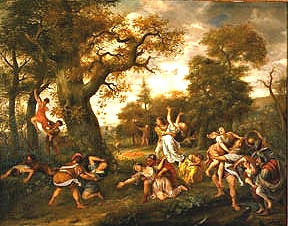 |
|
The Rape of the Sabine Women
by Jan Steen, Dutch 1626-1679
SN 269 Oil on Canvas 1665/67
by Robert Anderson:
Artist:
Jan Steen was born at Leyden in 1626 and studied at the Hague under Jan van Goyen. He was
a great narrator and humorist and excelled in the characterization of the Dutch middle
classes. He is best known for his genre scenes depicting busy interiors, often with a
strongly moralizing theme and frequently illustrating Dutch sayings. His work, in which
his goal seems to have been to combine narrative, instruction and entertainment, revives
the moralizing tradition of earlier Dutch genre painters. |
The spectator of Steen's paintings was compelled to see the
attitude, gestures and facial expressions of one of his figures together with the
reactions they cause in face, limbs and body of one or more other figures.
Steen's humor functions on two levels simultaneously. At first sight the
comical effect seems to rely solely on overstatement : strong and schematic
characterization, expressive and often grimacing faces and rhetorical gestures. At the
same time, however, there are subtle innuendos and ambiguous hints in the narrative that
create an amazingly wide margin for the spectators own interpretation.
His few biblical and mythological subjects were sometimes treated as if
they were genre subjects. He transplanted them to his own time and place so as to make the
stories more accessible to his audience.
Steen was a prolific artist who executed biblical and mythological
subjects as well as his many genre pieces. He also painted a few portraits and excelled in
the depiction of children. At the end of his life he produced paintings that foreshadow
the Rococo idylls of 18th century artists.
Subject:
Romulus, the founder of Rome, in order to secure wives for his settlers, arranged some
public games and invited the Sabines and other tribes to attend. During the races the
Romans seized the Sabine women and drove off the Sabine men. The Sabine King then declared
war on the Romans and marched upon Rome. As the Sabine troops neared the heart of the
city, the Sabine women secured an armistice on the plea that they would lose their
husbands if the Sabines won and lose their brothers or fathers if the Romans won. Romulus
then persuaded the Sabines to share the kingdom with him.
Painting:
Steen treats the old Roman legend with the humor of a merry-hearted Dutchman. The Roman
heroes and Sabine women are depicted as Dutch Boers and Boerins. He has painted a lovely
pastoral scene and has turned the "Rape" into a somewhat jolly event - humorous,
but carrying a moral lesson in the iconographic elements that are inserted. For example -
the girl in the center foreground reaches in despair towards the girdle (a ribbon), rose
and pearls on the ground, symbols of her lost innocence; - tendrils of ivy, symbol of
marital fidelity, have been loosened from the trunks of trees in the foreground and at the
far right; - the girl is also dropping flowers on the ground as a leering figure from the
repertory of the Commedia dell'Arte grasps her.
The brilliant feeling of Jan Steen for textures and colorful clothing and
the marvelous energy of his figures are readily apparant in this painting. These pairs of
struggling figures are linked back and forth in space across the foreground stage of the
painting and the branches of the trees repeat the frenzied gestures of the girls.
Historical Context:
The idea of Woman as a victim (and sometime victor) is extremely common in Dutch art and
in Steen himself ; for example, in a painting in the Rijksmuseum, Amsterdam, he shows
Erysichthon selling his daughter Hypermnestra for food. The artist treats other themes
such as a sacrifice of Iphigenia and also the banquet of Antony and Cleopatra, in which
the woman defeats the man.
|
